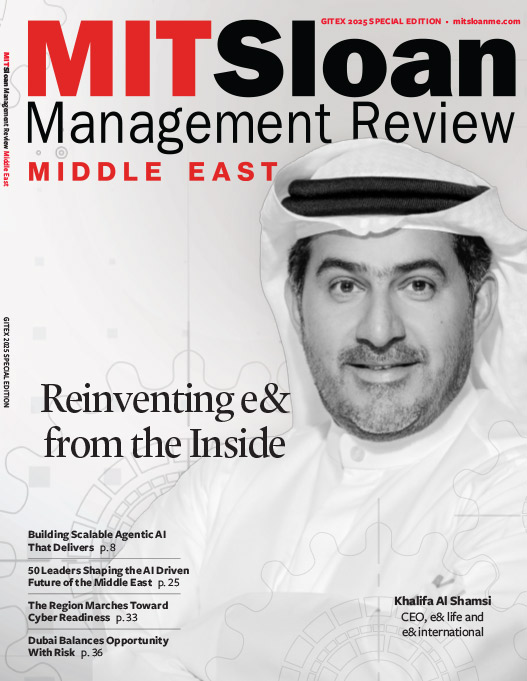Reinventing e& from the Inside: Khalifa Al Shamsi’s Framework for Scale and Trust
Once the region’s archetypal telecom operator, e& has been quietly remaking itself into a global technology group.
News
- Gemini Named Most Culturally Aligned AI in UAE’s First-of-its-Kind Index
- UAE Approves National Encryption Policy for a Post-Quantum Shift
- OpenAI API Users Hit With Third-Party Security Breach
- Uber and WeRide Launch First Driverless Robotaxi Service Outside the U.S. and China
- UAE Unveils Its First Marketplace for Buying and Trading Trademarks
- ACI Flags Sharp Rise in ‘Friendly Fraud’ as Thanksgiving–Cyber Monday Spike Looms

Khalifa Al Shamsi, CEO, e& life and e& international [Image creative: Chetan Jha/MITSMR Middle East]
The story of modern telecommunications is often told as a slow-motion collision between two forces: the relentless commoditization of connectivity and the impossible demand for reinvention. For e&, the UAE-based group that long sat at the carrefour of public ambition and private enterprise across the Middle East, Africa and parts of Europe, what looks, at first glance, like a bold choice is in fact a carefully designed strategy.
Sometimes the secret to success, the CEO of e& life and e& international, suggests, is hidden in plain sight: “The key is to be the go-to app people open first whenever they need to get something done.” Bake in trust by design with clear data controls and accountable AI in every market. Allocate capital with discipline, using a build, partner, invest approach, and recycle capital when it strengthens the portfolio.
That framework, he explains, has guided e& life’s expansion into digital finance, entertainment, and everyday needs, and e& international’s scaling of repeatable blueprints across MENA, Africa, and Central and Eastern Europe. In his dual mandate, Al Shamsi is balancing innovation in consumer digital platforms with the operational scale of international telecoms, a rare combination of entrepreneurial agility with telecom distribution reach.
This article is part of GITEX 2025 Special Edition.

Simplicity as a North Star
Technology was often accused of adding complexity to people’s lives. e& life was founded on the opposite premise of bringing simplicity. Interestingly, while tech executives often talk in architectures and road maps, Khalifa talks in steps. “Simplicity is something I will continue to push for every time. I ask for one less step in every customer’s journey, and our goal is to design this journey to make each step faster, simpler, and more intuitive. We build with privacy by design, and we scale what customers love.” The principle is deceptively exacting: one fewer tap, one fewer field to complete, one fewer distraction between a person and the service they need.
That minimalism is baked into concrete product choices. e& money, the group’s fintech superapp, is positioned as the platform of choice for financial inclusion, expanding from world-class digital remittance to cards, IBANs, and now salary and wealth solutions, and a unified rewards journey that travels with the customer across services.
And then there is the work that’s more consequential. “We build for real people with real needs. Together, with MoHRE, wage protection now lives inside the app for thousands of domestic workers, who previously had to rely on cash payments. That is what design with dignity looks like.” By folding wage protection into a digital wallet, e& money has now integrated informal wages, simplified salary transfers, reduced reliance on cash for vulnerable workers, and turned it into a measured product intervention: employers see verified worker details; workers receive IBANs, digital wallets and prepaid Mastercard cards. That single fact (digital financial inclusion integrated into a mainstream app) gives the company both social purpose and a new source of transactional data to improve services.
Numbers underline the point: e& money tripled gross transaction value in H1 2025, surpassed 1.25 million cards issued and more than 1.9 million registered users, and saw remittance GTV expand 3.1x year-over-year. These are not vanity metrics; in Khalifa’s vocabulary they are signals that a platform is maturing as it becomes an essential part of daily life.
Architecture of Advantage
If the consumer story is product-led, the corporate story is governance-led. The CEO’s argument about why e& can play this double role (telco and platform builder), better than any big-tech company in the region rests on three pillars: “governance first, capital discipline, and regional fluency. We build trusted, sovereign, culturally tuned platforms across MENA, Africa, and CEE, earning that role one country at a time.”
Governance here is not a compliance afterthought—it is engineering. The group’s UAE Sovereign Cloud Launchpad and a group-wide AI governance layer are designed to ensure models are traceable, risks are monitored in real time, and data that must stay in-country does so. These long-horizon investments are hard to replicate quickly, creating durable, locally compliant differentiation in markets where governments meet regulatory and sovereignty requirements.
Distribution is equally structural. e& life is increasingly enriching telco distribution: retail footprints, billing integration, customer-care capacity and millions of active accounts. “What sets us apart is not features, but the value engine behind them. e& life brings consented first-party data, telco-grade distribution, and a single wallet into one platform, then adds sovereignty and governance that regulators trust.” The result is lower acquisition costs, faster payback and a durable multi-service customer base.
Scale, however, is not monolithic. Khalifa is deliberate about geography. The group operates across different markets and has organized itself into five pillars, e& UAE, e& international, e& life, e& enterprise, and e& capital, so that playbooks translate regionally with local oversight.
This article is part of GITEX 2025 Special Edition.

The Arithmetic of Platform Bets
Acquisitions and investments are everywhere in the modern telco playbook. Yet his filter is strict. “We green-light initiatives where our unique group strengths give us an edge in distribution and trust and where we can see a near-term path to sound unit economics. We look for platforms that spark multi-service engagement and operate under clear regulation.” The group’s investment in Careem Everything App is a textbook example: Careem brings founder-led bold vision and speed-to-market as well as state-of-the-art engineering teams; e& augments these capabilities with further distribution and regulatory trust.
The value creation process that follows is critical. Khalifa is candid: “Investment is only the beginning; the real work lies in synergy creation and scale.”
Across markets the results are visible: in Egypt the group launched a unified e& Fintech & Digital Lifestyle offering and e& Business for SMEs; in Pakistan the UPTCL app pulls multiple services into one user flow; across the region the Africa-1 submarine cable landing and PTCL Flash Fiber’s >760,000 FTTH subscribers are examples of how capacity and last-mile reach underpin new experiences.
Quiet AI, Loud Outcomes
The dual-hatted CEO is wary of the hype cycle. He resists the industry’s temptation to dress AI in grandiose claims. His lens is sharper: AI that fades into the background while augmenting the experience. For him, AI is about subtraction—removing friction, delay, and error from everyday digital life.
“The best AI,” he says, “is the one you don’t notice. The biggest wins right now are when AI takes something noisy and makes it seamless: predicting network congestion before it happens, resolving a customer issue before it becomes a complaint, or automating back-office processes that used to take hours.”
That pragmatism is apparent in how e& has engineered its AI layer. Every model across the group sits inside a live governance spine that is auditable, explainable, and monitored in real time, so risks are flagged before they scale, and every outcome can be traced. “We don’t treat governance as a brake on innovation,” he says. “We see it as the foundation for scaling.”
The outcomes are visible: predictive fault detection in networks that reduces outages; AI-powered traffic management that eases congestion; energy optimization that lowers operating costs and carbon footprint; and recommendation engines that personalize experiences without compromising privacy. AI-driven personalization in STARZ ON and Smiles is lifting engagement and reducing churn. In customer care, automated triage resolves a growing share of queries without escalation, freeing staff to focus on higher-value interactions.
But while much of the industry discussion around AI centers on efficiency and cost optimization, he insists that “the true potential of AI—particularly agentic AI—lies in its ability to unlock business models that were previously inconceivable.”
He elaborates on this, “We are moving into a phase where AI does not just enhance existing workflows, but acts as an autonomous collaborator: creating new markets, designing products in real time, and orchestrating services dynamically across borders. For companies like e&, AI is not just a layer of intelligence; it is a foundation for entirely new forms of value creation.”
That next frontier is playing out in enterprise-scale adoption. With partners like Microsoft and Infobip, e& is deploying generative AI and omnichannel engagement across markets in KSA, UAE, Egypt, and Qatar, helping governments and large enterprises deploy AI stacks that are both compliant and effective—proof that responsible AI can scale across complex regulatory environments, while also hinting at what comes next: an era where ecosystems are reshaped and industries redefined by capabilities that only AI can deliver.
Founders, Partners and the Rails to Scale
Ecosystems don’t thrive on capital alone; they need an incubating infrastructure. Khalifa’s model for startups is surprisingly simple but unusual for a company of e&’s scale: plug once into e&’s ecosystem, then scale regionally, treating distribution as infrastructure rather than privilege. “If a founder has built something valuable, we open our rails so they can scale it faster and safer,” he explains.
These rails span consumer platforms like Careem and Smiles, fintech engines like e& money and Wio, and enterprise channels that reach governments and large corporations when founders need B2B scale. “The principle is one-time integration, multi-market reach. Plug in once, and the same setup can extend across the UAE, KSA, Egypt, Morocco, and beyond, always with local compliance in place,” Khalifa clarifies.
This type of access improves the odds for a young company. For founders, it can mean the difference between surviving in a single market and thriving across multiple regions. Startups that once struggled for years to build payment systems or negotiate with regulators now leapfrog straight into mass adoption. A healthtech startup can go from pilot to millions of users by surfacing inside Careem. A media creator can be distributed instantly through STARZ ON’s FAST channels. A fintech can ride on e&’s payment rails rather than build its own.
For e&, the benefit is equally rewarding. Every startup onboarded means a richer catalog of services inside the ecosystem, higher customer retention, and accelerated proof of sustainable unit economics.
Partnerships follow the same logic. e& invests where its infrastructure adds genuine advantage; whether that’s the trust that comes with regulatory relationships or the low-cost distribution that comes from telco-grade billing and retail networks. The result is a portfolio that not only accumulates startups but compounds value through network effects. “The real test,” the CEO notes, “is whether our platforms make others more successful. If they do, then the ecosystem grows stronger and so do we.”
The Regulatory Tightrope and the Sovereign Advantage
For most companies, regulation is an obstacle. Managing operations across 19 countries with diverging regulatory systems could have been e& international’s greatest challenge. As CEO of e& international, the global telecom arm of e&, he views it as a competitive advantage. “Regulation is not an obstacle course,” he says, “it’s an engineering challenge. If you’re willing to reconfigure your business model, sovereignty becomes an advantage.”
This discipline has become a source of trust in markets where regulators are cautious and data sovereignty is paramount. “Our edge is that we engineer for compliance from the start,” he adds. “We don’t bend around rules after the fact; we design platforms to meet them natively.”
This means keeping sensitive data in-country, building AI systems that are auditable in real time, and offering sovereign-ready cloud options for governments and enterprises that demand local control.
In Egypt, e& money secured early approval to launch fully digital international remittance services because its architecture met central bank standards from the outset. In the UAE, the sovereign cloud launchpad already hosts critical workloads for government partners who require verifiable in-country data residency, traceable AI models are auditable, and trusted cloud services that are sovereignty-ready.
While global hyperscalers often rely on local partners rather than direct sovereign infrastructure, e& provides a direct, regulator-approved alternative, making compliance a competitive advantage rather than just a cost.
Measuring What Matters
If the old telecom industry was measured by subscriber counts and ARPU, what about platform retention?
Khalifa’s yardstick is behavioral metrics: “The real question is how often people come back, how much value they entrust us with in their daily needs, and whether their loyalty deepens over time,” he explains. “Scale is meaningless if people don’t stay with you,” he adds. “That’s why in e& life, we measure activity, retention, and the share of daily needs we fulfill. In e& international, it’s about trust, profitability, and local relevance.”
This shift is evident in how the group reports progress. The data tells a story of habits, not just growth as Khalifa points to the depth of engagement: STARZ ON crossing 10 million installs; Smiles users who engage across multiple services, generating multiples of single-service value; Wio crossing into profitability while tripling deposits in a short span. Each of these is a signal that customers are moving from trial to habit. Households are making e& their entertainment hub and digital banking has shifted trust to e& rails.
For him, these are the real KPIs of transformation: not how many customers are signed up, but how deeply e& is woven into their financial, entertainment, and everyday trust.
The same approach applies to e& international’s footprint. Markets are judged on profitability, local relevance, and trust with regulators as much as scale. In Egypt, for example, Khalifa considers the launch of a fully digital remittance service not just as a product milestone but as proof that customers were willing to migrate sensitive financial flows into a digital channel they trust.
The CEO’s point is consistent: metrics matter, but only when they measure behavior and durability. “Subscriptions are a starting point,” he states, “the true measure of progress is when people rely on you, day after day, for services that are central to their lives.”
Ambition Grounded in Relevance
Khalifa’s horizon is not an empire built on vanity metrics, but rather platforms that people trust and choose. “Our vision,” he says, “is to make e& life and e& international the most reliable and trusted entry points into the digital world for millions of people.” At e& life, that means services people return to daily for their financial, entertainment, or everyday needs. At e& international, it means tuning to local contexts while ensuring profitability.
With 182 million customers across 19 markets, his ambitions are vast, but the lens is local. Trust and profitability come before sheer scale.
This ambition is realized when e& money transformed wage protection from paper cash to secure digital channels for domestic workers; when families choose STARZ ON or Smiles because the experience is simpler and safer. Each moment may seem small on its own, but for Khalifa, together they mark a shift: technology making everyday life more practical, more inclusive, and more trusted.
“If we can help people manage money with dignity, enjoy culture on demand, and communicate with confidence, then we’ve succeeded in delivering on the technology’s promise,” Khalifa concludes. “Success isn’t about being everywhere. It’s about becoming an essential part of daily habits that last – people who keep choosing us because we make their lives simpler and safer.”
About the Author
Moushmi Sinha is the Deputy Editor for MIT Sloan Management Review’s India and Middle East editions. She leads editorial strategy and content development across themes of management, innovation, and digital transformation.
View More





